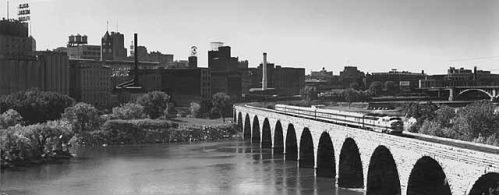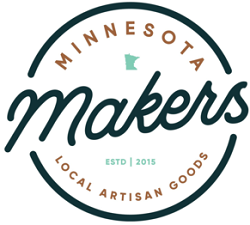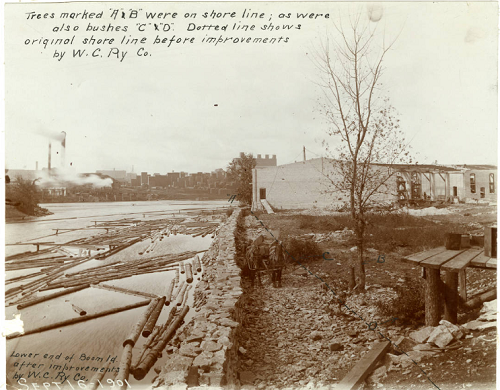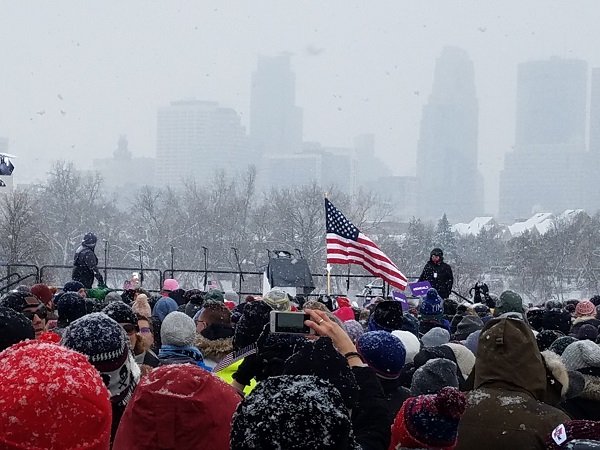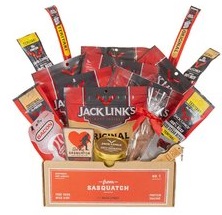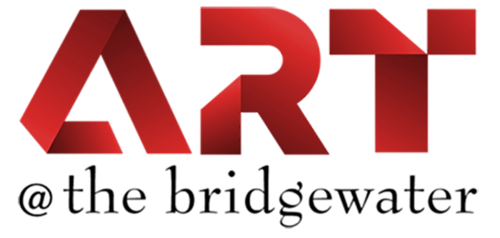
My Policy Priorities for 2019
The City Council began meeting in 2019 on January 7, and this Friday, February 15, marks the end of our third full cycle. As my first newsletter of the year, this is a great opportunity to outline some of my policy priorities that I'll be working on in 2019 -- many of these are covered in more detail in stories below this one, so read on:
- The Public Works Department will spend most of this year developing our next 10-year Transportation Action Plan, which builds on the foundation of the Minneapolis 2040 comprehensive plan to identify specific strategies and actions we need to pursue to meet those goals.
I'll be following this process very closely, and I encourage everyone in Ward 3 and across the City to add your input to it. Join me at Honey (at 205 E. Hennepin) next Wednesday the 20th from 5:00 - 7:30 for my first Ward 3 Happy Hour, where I'll discuss the Transportation Action Plan with Public Works staff.
- Last year, I started the process for a Data Privacy ordinance, and I will be working to develop that ordinance this year. One aspect of that ordinance will be our use of surveillance technology; the Public Safety Committee recently received a report on our use of cameras, which served as a good starting point for this discussion.
- Residents have recently shone light on data available through the Police Department's data dashboards that show clear inequities in some of our traffic stops, specifically for equipment violations. I think this issue is one worth digging into to see if we can pursue our public safety goals in a more equitable and effective fashion, and that's going to take time and effort to do right.
- Affordable housing has been a top priority of mine since day one, and that hasn't changed from last year. We have a good set of affordable housing projects in the pipeline in Ward 3 in the next few years, but we need to accelerate our pace and I will continue to seek the inclusion of affordable units in every project I possibly can.
- One specific housing-related policy that I am interested in pursuing this year is a workable definition of housing affordability for students and student housing, which is of particular relevance in our Ward and a thorny problem to tackle. Our current affordability definitions by median income could have the perverse effect of most benefiting those students with the highest debt load, and penalizing those who are working their way through school and who most need access to affordable housing.
- I was thrilled to hear that Minneapolis and Saint Paul got selected last year for Bloomberg Philanthropies' American Cities Climate Challenge, and I am super excited that one of our areas of work that they'll be helping us develop is on transportation hubs and Mobility as a Service. If we are going to meet the challenge of climate change head-on, we need to continue to decrease our use of cars by allowing folks to get around in other ways: walking, biking, on public transit, on scooters, via car-share (like HourCar), via ride-hail services like Uber & Lyft, and in ways we haven't thought of yet -- AND we need to make all of those options as seamless as possible. That's what our transportation hub and Mobility as a Serviceinitiatives are all about.
There's lots more that I expect will be coming through the City Council this year, and more that I'll be working on. If there's a policy item that you think should be a priority for me this year, contact my office and I'd love to hear more about it.

On January 22, Public Works staff presented to the City Council’s Transportation and Public Works Committee a vision for developing the next Minneapolis Transportation Action Plan. It will identify specific strategies and actions the City and our partners need to take within the next decade to implement the transportation policies of the Minneapolis 2040 Comprehensive Plan, which has been sent to the Metropolitan Council for review.
The Minneapolis Transportation Action Plan will guide transportation decisions to ensure alignment with these goals: safety, equity, prosperity, climate, mobility and active partnerships. It’s focused on the following topics: advanced mobility, pedestrian, bicycle, transit, freight, street operations and street design.
Public Works will conduct community engagement to gather input and feedback on the Minneapolis Transportation Action Plan throughout the year. A draft plan will be released later in 2019, and staff will seek official public comment on it at that time. Staff is expected to submit the plan to the City Council for approval in late 2020.
Please join me at a Ward 3 Happy Hour to learn more about the Transportation Action Plan and share your feedback to help shape it:
Wednesday, February 20
5:00 - 7:30 p.m.
Honey, 205 E. Hennepin Ave.
Visit go.minneapolismn.gov to learn more about the Minneapolis Transportation Action Plan and upcoming engagement opportunities, or search #gompls on social media.
The public comment period is open for the Neighborhoods 2020 framework recommendationson neighborhood programming, funding and governance structure for the City’s 70 officially recognized neighborhood organizations in 2020 and beyond. The public comment period runs through March 31.
The recommendations align with the Minneapolis 2040 Comprehensive Plan, which states that “Minneapolis will have an equitable civic participation system that enfranchises everyone, recognizes the core and vital service neighborhood organizations provide to the City of Minneapolis, and builds people’s long-term capacity to organize and improve their lives and neighborhoods.”
Goals include:
- Organizations reflecting the communities they serve.
- Simplifying participation for all.
- Saving money and staff time for participating organizations.
The public can comment in person at community information meetings or in writing. All meetings will have interpreters available and will take public comments. Meeting dates include:
- Feb. 27 6-8 p.m.: Eastside Services, 1700 Second St. NE (held in English)
- March 8 11 a.m.-12:30 p.m.: Harrison Community Center, 503 Irving Ave. N. (held in Lao and Hmong)
- March 13 6-8 p.m.: Cedar Riverside Opportunity Center, 505 15th Ave. S. (held in Somali)
- March 15 6-8 p.m.: Waite House, 2323 11th Ave. S. (held in Spanish)
Additional meetings will be scheduled in multiple languages. See the most up-to-date list at Minneapolismn.gov/ncr/2020. The final policy recommendations are tentatively scheduled to go before the City Council in April.
More information is available at minneapolismn.gov/ncr/2020. The Neighborhoods 2020 framework recommendations are online in English, Spanish, Somali and Hmong.

Photo credit: Aaron Lavinsky, Star Tribune
In the Public Safety Committee meeting on February 6, we heard from a number of community members raising concerns about racial bias in traffic stops, both in who gets stopped, and in which stops get escalated to searches. The Star Tribune covered the discussion in this story.
A group called the Racial Justice Network is organizing to demand a moratorium on equipment violation stops (for things like a broken tail-light) as a strategy for reducing racial profiling. We also heard from community members who have heard from MPD that these traffic stops are an important tool for getting guns off the streets, and asked us to prioritize that over people's concerns about profiling and harassment. As I said during the meeting, I think that's a false choice.
We owe it to all of our residents to design smart, effective public safety strategies to get guns off the street and eliminate gun violence in our community.
**AND**
We owe it to all of our residents to treat everyone fairly, and to make every department in our city a resource, rather than a cause of harassment and fear.
So, the real question is this: are traffic stops an effective tool for reducing gun violence? MPD presented some limited data, and based on what we know right now, it's hard to argue that they are. In 2018, we made 40,000 traffic stops and recovered 97 weapons.
Those stops are disproportionately in neighborhoods in North Minneapolis, and are disproportionately stopping African American drivers. People know when they're being targeted unfairly, and each time someone is pulled over with a brake light as a pretext to question them and maybe search their vehicle, it adds to a sense of mistrust that makes it harder to solve crimes and address the violence we're trying to prevent.
This is against a backdrop of a 70% drop in traffic stops city-wide, after we cut our traffic enforcement unit. My office routinely receives requests for increased safety enforcement to curb dangerous driving behaviors in more affluent neighborhoods. The impression in many parts of the city is that we don't do traffic stops at all, and in other parts, that we stop people all the time, but using traffic safety as a pretext.
So, I'm not ready to support it yet, but I'm inclined to take the community demand for a moratorium on equipment stops very seriously. We could achieve a similar traffic safety outcome (informing vehicle owners their light is out) with a postcard, rather than a stop that exposes a driver to potential escalation.
Before we commit to something like that, we need more data and more specific information from MPD, and I'm going to work to get it. Specifically, we need to know how many of these stops are pretext stops, as opposed to traffic enforcement for traffic enforcement's sake. We can be fairly sure that the percentage is very high, but drilling down into how this works in practice will help us understand whether there are legitimate public safety reasons to do something short of a moratorium.
I'm also always open to constructive suggestions from community and from MPD about better ways to eliminate racial bias from our policing practices, and approach community safety in a smarter way that builds trust and makes everyone safer.
You can view the committee meeting, including public testimony, here.
You can view MPD's data dashboard here (and, if I may brag for a minute, our Police Department under Chief Arradondo's leadership has one of the best, most transparent open data platforms in the country for police data).
Please continue to share your thoughts and feedback with me at steve.fletcher@minneapolismn.gov.
One of the components of hosting a Super Bowl is providing a very high level of security, which often includes new technology and surveillance capacity. In Minneapolis, there are 20 cameras that were added by Verizon last year that have not yet been taken down. The Minneapolis Police Department is now considering a proposal from Verizon to sell us the cameras so that we can leave them up, rather than take them down.
I want to make sure we have a real public discussion of this, especially because constituents raised concerns last year about temporary Super Bowl-related surveillance becoming permanent. We received a report from MPD in the Public Safety committee on February 6 that outlined our current surveillance capacity: how many cameras we already have (212), where they are located, who can access them, and how they are used.
Surveillance cameras are a complex issue. I'm someone who takes privacy concerns very seriously, and worries about the way these cameras might be used. I'm critically aware that data privacy is one of the major issues of our time, and that cameras take on a different meaning in the age of high-resolution digital images, facial recognition and other software advances that are here or on their way. (For the record, none of our current surveillance capacity has the ability to be run through facial recognition software. That's not something we do, or can do.)
If we were just making this decision based on what makes me feel comfortable, we would not install any surveillance cameras, and we would take down the Verizon cameras, most of which are aimed at my neighborhood along Washington and near the stadium in Downtown East.
That said... I've also heard from constituents who wish we had more cameras, and who express feeling safer when they know someone is watching. I've received a few calls this year in this office when something bad has happened from constituents hoping that we have footage of an incident. While it's not an approach I share, we shouldn't discount anyone's concerns in this discussion. I want to take seriously both people's right to privacy, and people's desire to feel safe.
It's possible this specific decision won't even be about privacy - we might find out Verizon wants too much money, or the cameras are placed in way that's not helpful to us, and it doesn't make sense, regardless. That said, we're planning to have a deeper conversation about surveillance and data privacy generally this year, and since this proposal is coming up now, I'm hoping we can use this as a launching point for that conversation. So... if you're someone who has strong feelings about surveillance cameras, send me an e-mail at steve.fletcher@minneapolismn.gov.

On January 22, Public Works staff also presented findings from the Vision Zero Crash Study to the City Council’s Transportation and Public Works Committee. The data will help guide infrastructure investments and inform the City’s Vision Zero Action Plan, which is under development to advance the City’s goal of eliminating traffic deaths and severe injuries on City streets by 2027.
Key findings from the Vision Zero Crash Study include:
- An average of 11 people were killed and 84 more suffered a life-altering injury on Minneapolis streets each year from 2007 to 2015.
- Pedestrians are the most vulnerable road users followed by bicyclists. Eleven percent of reported pedestrian crashes resulted in a severe injury or death compared to 5 percent for bicycle crashes and 1 percent for vehicle crashes.
- Crashes and injuries in Minneapolis are concentrated on a small percentage of streets. Seventy-five percent of severe and fatal pedestrian crashes happened on 5 percent of streets, 81 percent of severe and fatal bicycle crashes happened on 3 percent of streets, and 63 percent of severe and fatal vehicle crashes happened on 4 percent of streets.
- Crashes are disproportionately concentrated in low-income neighborhoods with a majority of people of color. Native Americans are most disproportionately impacted by traffic deaths.
We had a robust discussion about this in committee, and will keep pushing for safety improvements at the intersections listed on the crash data map, as well as proactive work to prevent more intersections from being added to that map. MinnPost covered this report and our committee hearing on it very well in this article; I recommend giving it a read.
The Vision Zero Crash Study complements the 2017 Pedestrian Crash Study commissioned by the Public Works Department that analyzed more than 3,000 pedestrian-motorist crash records over 10 years from 2007 to 2016. The data from the crash studies will help shape the Vision Zero Action Plan and Transportation Action Plan. The two action plans are moving ahead on the same timeline and provide action steps for reaching the vision outlined in the Minneapolis 2040 Comprehensive Plan that will guide growth in the city over the next two decades.
The City of Minneapolis officially became a Vision Zero city in September 2017 when the City Council passed a resolution setting a goal of eliminating traffic deaths and injuries within 10 years. Traffic deaths and severe injuries are unacceptable and preventable. Minneapolis has joined more than 30 other cities across the country, including Austin, Texas; Boston; Chicago; New York City; Portland, Oregon; Seattle and Washington, in pledging to eliminate traffic fatalities and severe injuries.
The City’s Vision Zero Action Plan will put equity at its forefront and provide extra focus on protecting the most vulnerable users of the roadways: pedestrians and bicyclists. A Vision Zero Task Force made up of City leaders from several departments is guiding work on the plan and engaging local and regional stakeholders to consider the best approaches in street design, education, encouraging behavior changes, enforcement and legislative solutions to make the transportation network safer for everyone.
Learn about ways to get involved: visionzerompls.com.
When new policies take effect, consumers will have energy information before buying or renting
Starting over the next few years, homebuyers and renters will be able to learn energy information about a Minneapolis home or apartment before they sign on the dotted line. The Minneapolis City Council approved three policies that combined touch all housing types in the city:
- Residential Energy Benchmarking: A requirement that extends the existing commercial benchmarking ordinance to cover residential buildings 50,000 square feet and larger and requires an energy evaluation of properties with high savings potential. This policy will be phased in based on building size, with the first compliance date being June 1, 2019 for buildings 100,000 square feet and larger.
- Time of Rent Energy Disclosure: A requirement at the time of rent for residential building owners to disclose average energy cost per square foot. This policy will go into effect in 2021.
- Time of Sale Energy Disclosure: a requirement to include energy efficiency characteristics as part of the already-required Truth in Sale of Housing (TISH) report when selling a home. This covers information on the home’s insulation, heating system and windows. This policy will go into effect in 2020.
The goals of these policies are to reduce overall housing costs, ensure homeowners and renters have reliable information about their energy costs when deciding where to live, and reduce carbon emissions. These policies are recommended in Minneapolis’ Climate Action Plan and will help the City make progress toward its community-wide greenhouse gas reduction goals. Minneapolis joins nearly 20 other cities in adopting residential energy benchmarking for large buildings.
- Learn more about the requirements and rules for benchmarking and time of rent energy disclosure.
- Learn more about the requirements for time of sale energy disclosure.
Plug in to savings
Several programs are available to help property owners reduce energy use including:
- Homeowners:
- Can get a visit from the Home Energy Squad. The program is available at a low cost for all homes, and the City offers residents in Green Zones no-cost visits to improve energy efficiency for single-family homes, duplexes, triplexes and fourplexes. At the visit, energy experts identify opportunities to save energy and make some energy-efficient improvements on the spot.
- Can access zero-interest financing made available from the City for eligible energy efficiency improvements.
- Rental property owners:
- Can participate in the Multifamily Building Efficiency Program. This free, utility-funded program provides multifamily buildings (five or more units) with an assessment to identify energy-saving opportunities, directly install several energy-saving measures for immediate savings, and offer financial incentives for buildings that meet energy saving targets including covering up to 80 percent of the costs for energy upgrades in qualifying low-income housing.
- Can participate in the 4d Affordable Housing Incentive Program, which helps apartment building owners obtain property tax reductions if they agree to keep 20 percent or more of their rental units affordable. The program also helps owners make existing buildings greener through cost sharing for energy efficiency improvements and solar installations.
- Large multifamily and commercial properties can participate in the Green Cost Share energy efficiency program. The City offers a funding match of 20-30 percent up to $50,000 (not to be repaid) for residential buildings with four units or more and commercial buildings that increase energy efficiency.
Find the complete list of programs here.
I have heard from lots of people in the Ward about two different development proposals that will go before the Heritage Preservation Commission (HPC) soon:
- a proposal by Doran Cos & CSM at 311 2nd St SE, the former site of the General Mills Riverside Technical Facility, for a large housing development; and
- a proposal by the Federal Reserve Bank of Minneapolis for a large "Heritage Landing Parking Ramp" on the site of a surface parking lot that they own at 24 2nd Ave N.
The Doran proposal had a public hearing at the HPC meeting on January 22nd, and is currently scheduled to return to the HPC for additional public comment, and final discussion and action on March 6.
The Federal Reserve proposal went before the HPC for informational discussion on January 22nd, and will need to return to the HPC for a public hearing, discussion, and final action.
The HPC is the first step for both of these proposals, which will still need to go to the City Planning Commission for further review and land use approval.
I encourage everyone to continue to share your thoughts about these projects with me -- positive, negative, and in between - at Steve.Fletcher@minneapolismn.gov.

The Minneapolis Department of Civil Rights and U.S. Department of Labor signed an agreement formalizing their commitment to collaborate on investigations and public awareness of labor standards, including the City’s minimum wage ordinance.
The agreement will increase the capacity of both City and federal officials to enforce labor standards in Minneapolis to protect all workers and ensure that abusive employers seeking unfair competitive advantages are held accountable.
The collaboration comes as the City recognizes the one-year anniversary of the minimum wage ordinance.
More than 4,000 workers received back wages or new benefits because of investigations by the City’s Labor Standards Enforcement Division in 2018.
The City’s minimum wage ordinance has a phase-in schedule requiring large businesses to pay $15 an hour by 2022 and small businesses by 2024. Currently, the minimum wage is $10.25 for businesses with 100 or fewer employees and $11.25 for employers with more than 100 workers. The next minimum wage increase takes effect July 1, 2019.
Violations of the minimum wage ordinance can be reported by calling 311 or filling out an online form, or in person at City Hall, Room 239.
The ordinance supports the City’s goals of promoting inclusive economic growth by reducing economic and racial disparities. For more information about the ordinance, visit minimumwage.minneapolismn.gov, call 311 or email minwage@minneapolismn.gov.
On January 14, I co-hosted a meeting with State Senator Kari Dziedzic, along with staff from both the Minneapolis Public Works Department and the Minnesota Department of Transportation, about the upcoming central riverfront bridge repair projects on the 10th Avenue, 3rd Avenue, and Stone Arch bridges.
The City project on the 10th Avenue bridge is scheduled to go first, with a full closure of the bridge expected for all of calendar year 2020 and project completion in the first half of 2021.
MnDOT's project on the 3rd Avenue bridge will begin in late 2020, with a full closure of the bridge expected to begin in 2021. A full closure of two years is expected, with a total project duration of 30 months.
The City and MnDOT are coordinating as closely as possible to prevent an overlap in the full closure of the two bridges if at all possible.
The Stone Arch Bridge, also owned by MnDOT, is also in need of significant repairs. Senator Dziedzic was able to share at our meeting that that project is now fully funded, which is outstanding news. The full details and timeline of that repair project are yet to be determined, but we are hopeful that it will NOT need to be fully closed to pedestrian and bicycle traffic.
You can view and download the three presentations here (links are to PDFs):

Reconstruction of Hennepin Avenue downtown begins this spring with utility work from 12th St. to 7th St. The general schedule of this project is for a year of utility work followed by a year of street reconstruction, for each of two segments from South to North: 12th St. to 7th St., followed by 7th St. to Washington Ave.
At this time, project staff plan to maintain open lanes during the utility work (this year for 12th to 7th; 2021 for 7th to Washington) but full closure during the street reconstruction (next year for 12th to 7th; 2022 for 7th to Washington).
For more project information, a more detailed schedule, or to sign up for email updates, go to hennepindowntown.com.
At the beginning of January, I had the honor of joining the Minneapolis delegation to Harbin, China for a convening of their Sister Cities at their 35th Annual Snow and Ice Festival. Harbin has been one of our more active "sister city" relationships, and I think we succeeded in representing the city well, and deepening that friendship.
The government of Harbin showed us remarkable hospitality, arranging formal meetings with their leadership, a conference of all of their sister cities at which we all presented, a tour of the Harbin city hall, a visit to their urban planning institute and the Harbin Jewish Museum, a walk through China's longest outdoor pedestrian mall, as well as their new indoor shopping mall (which includes a curling rink and the world's largest indoor ski slope), and of course, the snow and ice festival itself.
It's a worthwhile exercise to visit unfamiliar places and see things that challenge your assumptions about your own city. As would be true of any city, I saw some things that I really liked that we could learn from Harbin, as well as some things that I wouldn't want Minneapolis to emulate. I was impressed with the multitude of seasonal uses they make of the river as a place to play, as a natural resource, as a center of activity. I really liked their Central Avenue, which is a car-free pedestrian street in the center of their downtown. Some of the modern architecture is big and bold and beautiful.
Most of all, I appreciated the unapologetic pride Harbin takes in its seasons. They proclaim to the world that they have a "strong winter", and they make it a real asset. People travel from all over China and the rest of the world to experience Harbin's winter, and Harbin makes that really fun, not just at the festival, but all over the city. That spirit's given me a little more energy to appreciate our own strong winter, and to think about the possibilities to turn our weather into more of an asset for residents and visitors.
You can see a set of photos from the trip on my Facebook Page.

Please join me at my first Ward 3 Happy Hour next Wednesday, February 20 to learn more about the Transportation Action Plan and share your feedback to help shape it!
More details in the 2nd story of this newsletter.
WHEN: Wednesday, February 20 from 5:00 - 7:30 p.m.
WHERE: Honey, 205 E. Hennepin Ave.
This year, we'll be holding Good Morning Ward 3 and Ward 3 Happy Hour events in alternating months, usually on the third Wednesday of each month.
Our next Good Morning Ward 3 will be:
Wednesday, March 20th -- 7:30 - 9:00 A.M.
Kramarczuk's, 215 E Hennepin Ave, Minneapolis, MN 55414
See you then!
Council Member Fletcher holds regular open community office hours at 5:00 p.m., normally on Wednesdays, at a rotating neighborhood coffee shop in Ward 3 for constituents to drop by, ask questions, and raise any issues you see in the community.
All are welcome! RSVP on Facebook or just show up. If you want to discuss a specific issue or project, email david.zaffrann@minneapolismn.gov and we'll add you to the agenda.
Keep an eye on our Facebook Page for all the details on future scheduled events, or contact our office at 612-673-2203.
 Sunday, February 17, 2019 at 10:09AM |
Sunday, February 17, 2019 at 10:09AM |  Claudia Kittock |
Claudia Kittock | 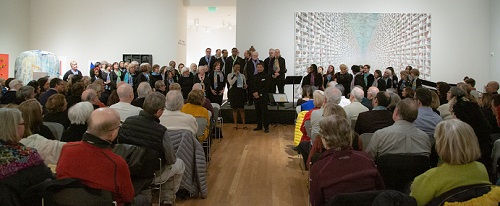 A heavy snow could not deter the audience from attending.
A heavy snow could not deter the audience from attending.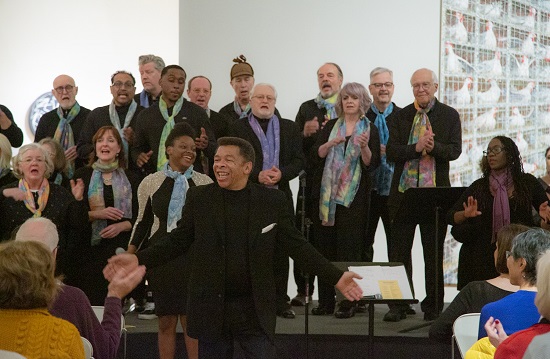 The Mill City Singers performed in their signature hand painted scarves.
The Mill City Singers performed in their signature hand painted scarves.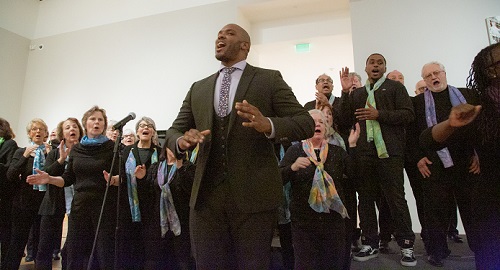 Tenor Dominique Wooten, front center, with the Mill City Singers.
Tenor Dominique Wooten, front center, with the Mill City Singers.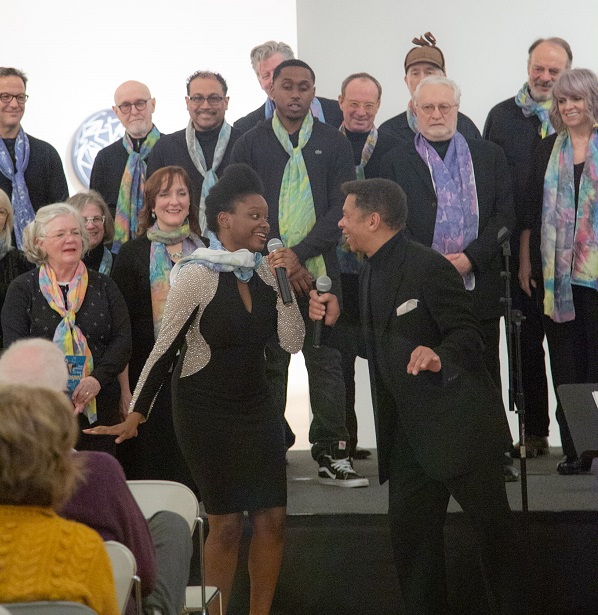 Michele Crowder and J.D. Steele with the Mill City Singers.
Michele Crowder and J.D. Steele with the Mill City Singers.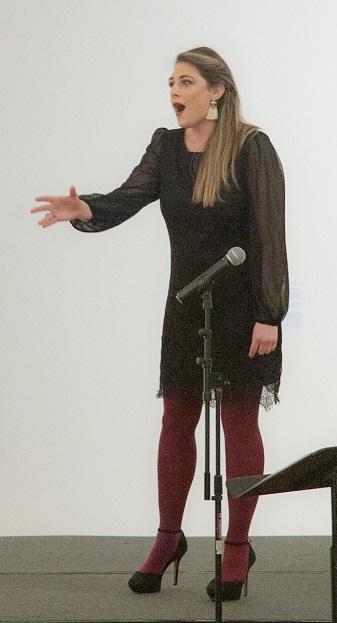 Soprano Alexandra RazskazoffDominique Wooten and Alexandra Razskazoff were the featured singers, alternating arias with gospel songs sung by the Mill City Singers. Then came the fusions pieces, led by Tonia Hughes and J.D. Steele with the Singers singing back up in the choruses.
Soprano Alexandra RazskazoffDominique Wooten and Alexandra Razskazoff were the featured singers, alternating arias with gospel songs sung by the Mill City Singers. Then came the fusions pieces, led by Tonia Hughes and J.D. Steele with the Singers singing back up in the choruses. About Claudia Kittock
About Claudia Kittock